What We’re Reading: House of Deer
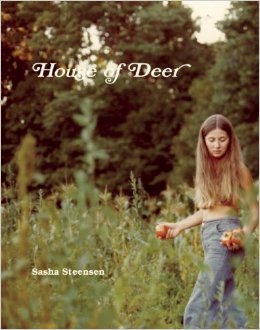 House of Deer by Sasha Steensen (Fence Books, 2014)
House of Deer by Sasha Steensen (Fence Books, 2014)
Sasha Steensen’s books are more lyric project than poetry collection. While many collections of poetry have themes that tie the poems together, Steensen’s books use their subject as a nexus around which the project grows, as if Steensen free-associated around the subject and developed individual pieces from there. House of Deer, Steensen’s intricate and lovely third collection, centers on her back-to-the-land childhood. Like her second collection, The Method (Fence Books, 2008), Steensen blends research and personal history through a process of addition, subtraction, and associative swerves.
House of Deer quotes, mentions, or makes references to Theresa Hak Kyung Cha, Gerard Manley Hopkins, George Oppen, and Baudelaire, among many others as a way to begin building (and it’s probable that this reader missed even more references). These connections are layered and reward repeated readings. The titular poem, “House of Deer,” mentions “the house on Hopkins Road,” where the reader assumes Steensen’s family lived; a later poem, “Fragments,” is noted as being written “after Hopkins.” This connection does not feel like an accident.
One of the more notable repeated references in House of Deer is Hart Crane, who was from Garrettsville, Ohio, where Steensen also grew up. His work and life become a starting point for Steensen to discuss familial tension, addiction, and self-destruction: “The family’s relationship with itself was strained. // This was meant to be a story about Hart Crane” (from “Fragments”). Later, Steensen quotes Crane (along with several other sources, all cited in parentheses in the text) in a piece called “Personal Poem Including Opium’s History,” which is dedicated to Steensen’s brother:
Instead, let’s talk about your closet full of weed.
If I could say sorry for that disclosure, I would.
But that’s too “the author-(to her brother)-to her book.”
Too Anne Bradstreet for me.
Yo-Ho! Sweet opium and tea (Hart Crane)
The Crane connection goes beyond a shared hometown. A “hart” is another term for a male deer; deer, like Crane’s life and work, serve as a way to enter into memory. Like deer, Steensen lived on the fringes—both of forest and mainstream culture—in a family unit that moved together: “sound of deer changing direction &then turning back,” as she writes in the section from which the book takes its name. Another section, “The Girl and the Deer,” is a retelling of a Zuni story. In it, Steensen tells “a story the writer cannot tell” of a girl, abandoned by her mother, being raised by a deer mother before her biological family kills her deer family and incorporates the girl back into their family.
Steensen’s method of composition could fall apart in any number of ways, but her attention to poetic lineage—the aforementioned references to Crane, Hopkins, et al—helps keep the project soaring (as it did in The Method). Further, Steensen displays a subtle attention to technique (learned, as she says in an interview with ZYZZYVA, from Crane). Take a standout piece like “A History of the Human Family:”
To find our First Family
what do we peer through,
what manhole or anthole?
what foxhole or portal?
what Afar Triangle?
It was 2.5 million years ago,
& it was eternal.
The intricate notice of sonic possibilities and meanings present here is found throughout the book adding a layer of complexity to the project that drives the reader forward.
Though Steensen’s method of composition may be very modern, she enters into dialogue with her influences and poetic-godparents. The effect is a complex, self-referential text that is as rewarding as it is difficult, which is to say very. Readers that enjoy layered poetic narrative will find a favorite author in Sasha Steensen.
What are your favorite “book projects,” as opposed to poetry collections?

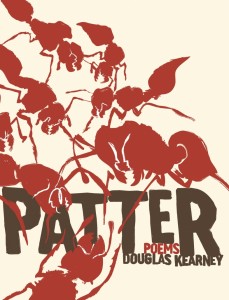 Patter by Douglas Kearney (Red Hen Press, 2014)
Patter by Douglas Kearney (Red Hen Press, 2014)
In Michael Ondaatje’s 1970 film The Sons of Captain Poetry, bpNichol, influential concrete and sound poet and the subject of the film, says, “The use of other media [is] an exploration of, ok if you’re gonna actually have a poetry which is visual, that is, is print and is put on a page, then why not actually utilize the page as the unit of composition and utilize visuality as its main feature?” I don’t know whether Douglas Kearney has seen this film and heard this quote, but he’s almost certainly familiar with Nichol’s work.
Kearney’s work flips easily from traditional left-justified lyric poetry to poems whose “performative typography” grows out of a long lineage of concrete and visual poetry, using, as Nichol suggested, the page itself as a main unit of composition. Poems such as “Every Hard Rapper’s Father Ever: Father of the Year” and “Noah/Ham: Fathers of the Year” are hard to imagine without the typographical elements: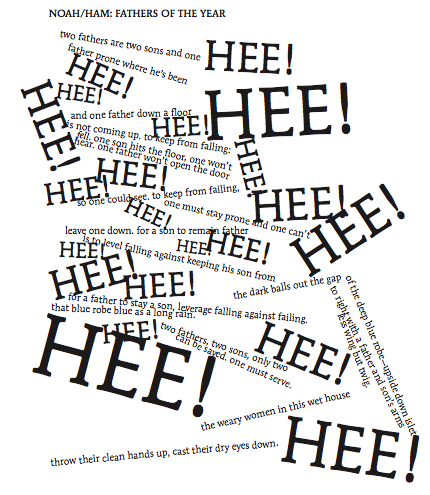
These visual poems are nothing new to Kearney’s readers; his first collection, Fear, Some (Red Hen Press, 2006), contained the same experiments, and 2009’s The Black Automaton (Fence Books) continued them. Luckily, Kearny introduces new elements to prevent the poems from what could, in less sure hands, become a gimmick. “The Miscarriage: A Sunday Funny,” for instance, owes more to comic books than to “Easter Wings:”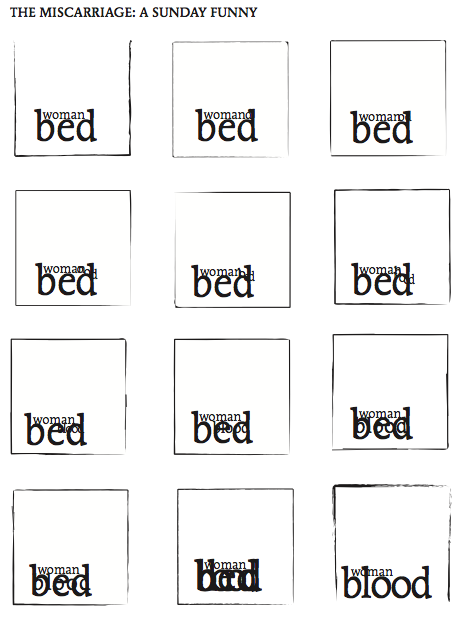
These visual elements create layers of meaning that are impossible with just text, and can, as in the poem above, even enact the event the poem seeks to describe. Notice how “blood” comes out of the “woman” who lies on the “bed” until the blood overwhelms both bed and woman.
Of course, reducing such a horrific event to a mere trick of type is an almost obscene over-simplification, but “A Sunday Funny” comes in a series of poems that tackle the same event using multiple forms and angles, including a short film script, a minstrel show, and “a poetic form”:
internal rhyme (perfect)
internal rhyme (perfect)
internal rhyme (perfect)
internal rhyme (perfect)
internal rhyme (perfect)
(volta)
internal rhyme (slant)
internal rhyme (slant)
internal rhyme (slant)
(volta)
internal rhyme (broken)
—“The Miscarriage: A Poetic Form”
Thanks in part to the seven “Miscarriage” poems, Patter is, if not Kearny’s most personal book, definitely his most intimate. The content delves into the difficulties of conceiving children and the traumas of miscarriage—traumas that are felt psychologically by both members of a couple, but physically by only one. Kearney’s interest in masculinity and the role of men in relationships, especially of black men, are present here as they were in his earlier work, but the damage of miscarriage—a very real event in Kearney’s life—is the fulcrum around which the book turns.
If the miscarriage is the heart of Patter then the refrain “I love your body. I hate it” are thump of the heartbeat:
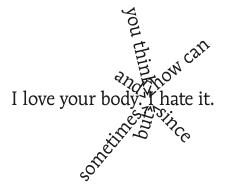
—from “Sentence Done Red” |
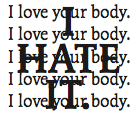
—from “Sonnet Done Red” |
Layered and reused throughout the collection, this refrain is a raw distillation of feeling that is surprising no matter how many times it appears. These poems are an intimate look into Kearney’s marriage and hint at the complex and heart-wrenching pain a miscarriage inflicts on a couple. The intimacy could turn some readers off, but ultimately it speaks to Kearney’s ability to tackle difficult subjects with his eyes wide open. Kearney (and his wife) lets us into his marriage, into his marriage bed, to explore what it means to be a father, when, and how one becomes a father.
It’s rare to find a poet who so bluntly and openly explores issues as personal as the ones in Patter. Euphemism and abstraction are generally the theme. What Kearney has done with this collection is assert himself not only as an innovator of visual poetry, but also as an important and far-reaching voice, unafraid to stare directly into tough topics and not blink. One of the sharpest tools in Kearney’s toolbox is the page itself.
What We’re Reading: The Other Poems

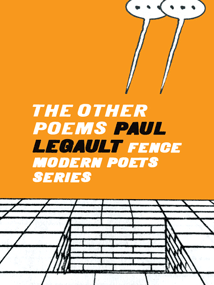 A dozen poems into Paul Legault’s second collection of poems, The Other Poems (Fence Books, 2011), a character named Ginger says, “Stairs always lead to more stairs. / Enough stairs make a house.” Ginger is one of hundreds of characters who show up in Legault’s collection of 75 “sonnets,” so if there’s any truth to Ginger’s statement then surely enough characters make a book. And with this many characters, the book is an energetic romp through the absurd.
A dozen poems into Paul Legault’s second collection of poems, The Other Poems (Fence Books, 2011), a character named Ginger says, “Stairs always lead to more stairs. / Enough stairs make a house.” Ginger is one of hundreds of characters who show up in Legault’s collection of 75 “sonnets,” so if there’s any truth to Ginger’s statement then surely enough characters make a book. And with this many characters, the book is an energetic romp through the absurd.
A Legaultian sonnet consists of the standard 14 lines, but abstains from meter and rhyme in favor of voices that speak to and comment on one another, and sometimes don’t seem to interact at all. These voices are anything from animals to people, objects to abstract ideas, all clamoring to be taken seriously, or at least heard. The poems open with a couplet, followed by four lines of dialogue, the last of which stretches into the next three lines, as in “Worst Christmas”:
Until the industrial revolution,
some animals were hitherto unknown.
DOG: I’ve never been to Atlantic City.
CAT: I’ve been to Catlantic City.
DOG: Oh, how is it?
CAT: You’re not invited.
I’ve heard people die. I’ve heard
the moon has a French lisp
and a thick dart and a pillow and some pockets.
The remaining five lines contain another three lines of dialogue, the last voice delivering an easy aphorism, botched epiphany, or legitimate bit of wisdom. Here’s how “Worst Christmas” ends:
AUTUMN: How many pockets?
CAT: There are at least two.
THE MOON: Count again.
What were we drinking when they told us:
you don’t need a gun in August?
Not all of the poems contain such a straightforward back and forth dialogue as this one does, but all of them begin and end in the same cryptic way, with the rest of the text bouncing around in the middle trying to make sense of it all.
Naturally, rules are made to be broken, and Legault breaks his own rules in spectacular and entertaining fashion, sometimes letting one voice take over a poem, other times giving a line over to stage directions or silence. “Seventh Grade is for Losers” contains this bit of dialogue:
SILENCE: What color am I?
GOLD:
GOLD:
GOLD: I want to be for cash
.
the way cash is for me.
The white space on the page between the two lines of dialogue is delightfully jarring to come across after so much talk. Other poems in The Other Poems contain too many lines, and one poem’s title is so long it’s almost a poem in itself. “Circular Breathing,” one of the later and most compelling poems in the collection, would read almost the same whether or not it was split into dialogue. Each of the lines begins with the same two words—“same old”—until the last line. The final couplet reads, “Same old being old / when you’re an old person.”
All forms come with their detriments, however, and the Legaultian sonnet is no different. So many lines of dialogue force lines to be clipped and simple, which means a complete syntactic phrase rarely, if ever, stretches more than four lines. (This seems to be a Legault trademark—his most recent book, An Emily Dickinson Reader (McSweeny’s Books, 2012), offers English-to-English translations of all 1,789 of Dickinson’s poems, the majority of which are one to three lines long.) In less sure hands, the short sentences would feel easy and boring, but Legault is savvy enough to shuffle in new tricks and surprising turns of phrase to keep the reader engaged. One stunning couplet spans over six decades and, it is inferred, hundreds of miles in the space of a single line break: “I wanted a sister when I was younger, / now she’s sixty-four in Arkansas.” Dizzying leaps of distance and image abound throughout Legault’s poems, insuring that the energy never wavers, it simply shifts and unfolds.
Legault is an exciting poet working on fascinating projects, and The Other Poems displays the strength of his poetic muscle. After reimagining the sonnet, Legault could have called it a day, but he chose to keep going, reinventing his own form again and again. Including his first collection of poems, The Madeline Poems (Omnidawn, 2009), Legault has published three books in four years. If his pace holds, we’re in for a wild ride in the coming years.
What We’re Reading: Harmony Holiday’s Negro League Baseball

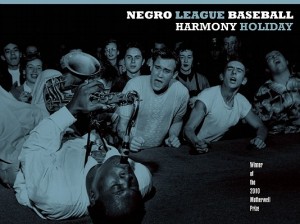 Harmony Holiday’s first collection of poems, Negro League Baseball (Fence Books, 2011) is an experiment, a textual cacophony, and a landscape of language. She sets out to find or create— “to clear a field/invent a field/demolish and reassemble” as she says in her afterword —a space in which to explore personal and collective memory, so that she can examine her relationship with her prolific jazz-composer father. Whether or not Holiday’s experiment is always successful aside, Negro League Baseball is often fascinating, and occasionally stunning.
Harmony Holiday’s first collection of poems, Negro League Baseball (Fence Books, 2011) is an experiment, a textual cacophony, and a landscape of language. She sets out to find or create— “to clear a field/invent a field/demolish and reassemble” as she says in her afterword —a space in which to explore personal and collective memory, so that she can examine her relationship with her prolific jazz-composer father. Whether or not Holiday’s experiment is always successful aside, Negro League Baseball is often fascinating, and occasionally stunning.
The pieces here are mainly prose poems, and since the book is wider than it is tall, Holiday’s lines are long, stretching all the way across the page. This lack of pressure on form creates a “pressure of idiom” as Holiday calls it in “Errand boy for rhythm[.]” She free associates through the pieces, turning “fast sin” into “fascination” (“Which Crosses You, Which Covers You”), and generally riffing on a theme like a musician.
While many poems are prose-like, line break is used throughout the collection as an disruption or cutting in. These interruptions seem to deconstruct the piece, pointing out the ragged edges where the text is collaged together. Interestingly, the text is rarely sampled from outside sources, so Holiday relies on cutting together her own generated text. Take “Vision Statement about the name Menelik”:
the Gospel is not primarily that at all, pretty champion
Prince, conqueror, pretty dancer
buggy, pretty dancer
university university university
put me to sleep
I was gone a solitary octopus/ pretty dandy
I didn’t wear any long purple or long
It helps to think of these lines not as being in sequence, but existing within one another in a way that the page doesn’t allow.
Included with the book is an audio CD that builds on the collaged theme found in the text. While Holiday’s text is her own, the audio draws more from found elements, including Nina Simone, Amiri Baraka, Antoine Dodson (yes, that Antoine Dodson), Mos Def, and many others. It’s helpful to reread Holiday’s text in the context of the audio, which gives a better idea of how the poems should be experienced.
And they should be reread, and read out loud, to better follow the leaps of sound and rhythm collected here. They should be read, occasionally, without any thought toward making sense, but rather toward making sounds. It is when these poems are read out loud that the reader gets a sense of Holiday’s musician father. As musical as the poems are, though, Holiday rejects the word “jazz” which leaps so readily to mind. The word has become “vapid and spangled through overuse and misuse[,]” Holiday says in her afterword. Perhaps she’s right. The poems (and accompanying audio pieces) have more in common with Laurie Anderson than with Louis Armstrong.
In a number of ways, Negro League Baseball is structured like a textbook, from the introduction and afterword, to the included audio. While these elements are interesting and helpful, they distract from the music of the text. There’s something to be said for poems that can exist without a theoretical framework to prop them up, and I wonder if Holiday’s experiments with language would hold up without the context she’s provided. I hope they do, and I hope she gives us an opportunity to experience them in such a way.





